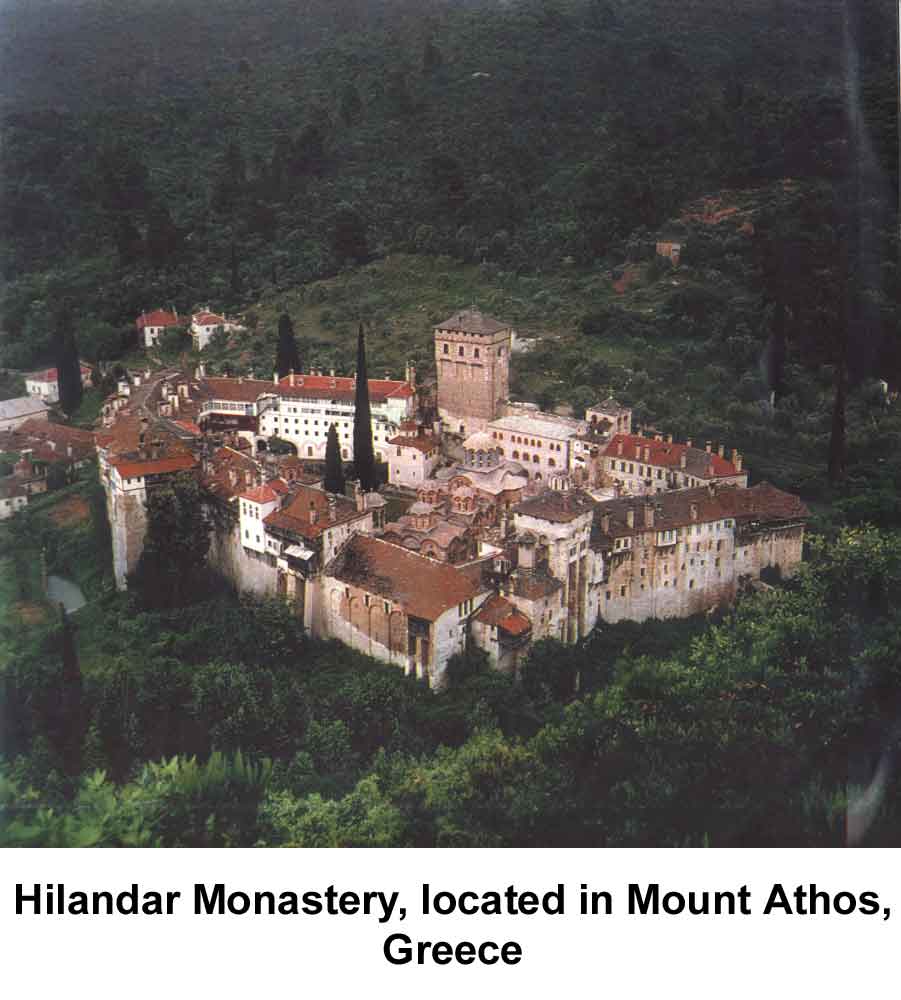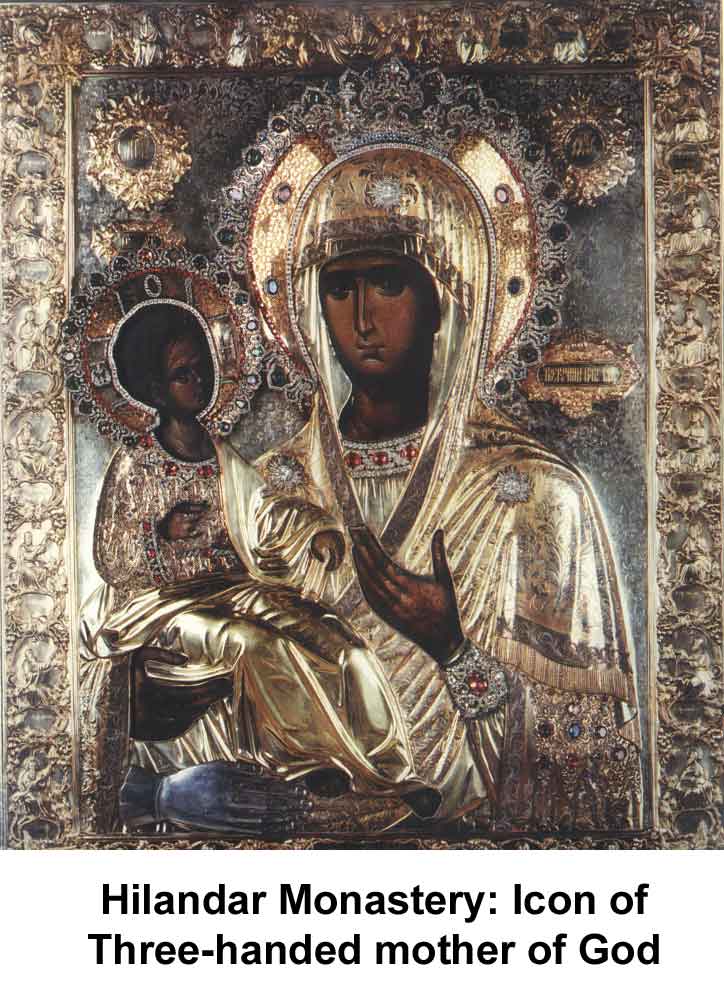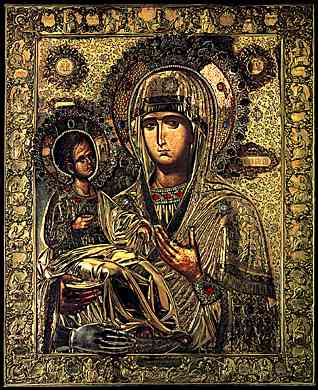Eight Centuries of Serbian Hilandar Monastery
Eight centuries ago, Byzantium Emperor Aleksei III gave a hrisovulja (an act or declaration) which grants Monastery Hilandar and the region around the monastery to be an "eternal present to the Serbs". He gave the act to St. Sava and his father St. Simeon (Stevan Nemanja). From this moment, Hilandar Monastery was for centuries to come, home to Serbs, Serbian religion and culture.
Many Serbian kings contributed to the enlargement and extension of the Hilandar. The Monastery Hilandar is located at the Aegean Sea in Greece, in the peninsula Mont. Athos. Through the past eight centuries, the Hilandar Monastery was the inspiration and enlightenment for the Serbian people.
Hilandar reaches its blooming during the period of the Nemanjiches. The number of monks was steadily increasing. On the Holy Mount, in those sacred times, thousand of monks were gathering and transmitting their knowledge, living heroic lives. Almost all our writers from the Middle Ages from St. Sava to Constantine the Philosopher, came out of the Hilandar school.
Many Serbian rulers from the Middle Ages carved their souls into the holy Hilandar walls. The King Milutin built the new cathedral, around 1300, on the spot of an old one, decorating it with frescoes, and dedicating it to the Presentation of the Holy Virgin. Milutin's example followed by czar Dusan, by his building and fortifying of the monastery. In the 14th century, the holiest of all Serbians dukes - Lazar, has built another vestibule in front of the cathedral. During the past centuries, twelve more of this small churches - chapels were built. The lodging shelters were built and reconstructed, the dining room was renewed, water-tanks were rebuilt, the kitchen as well, and the entrance into the monastery.
Hilandar acquired its today's shape at the beginning of the 19th century. Hilandar's old garments are today being redecorated with fast speed.
A Never-Ending Prayer
"The Holy Mount is an empire with no crown, a state with no army, a country with no women, a fortune with no money, wisdom with no books, a kitchen with no meat, a never-eating prayer, a never-ending link with the heavens, on Ode to never-tiring Christ, death with no mourning."
Nikolai Velimirovich, the Episcope





Iconostasis of the main church, executed in c. 1774. It forms an integral part of the church interior, together with the richly carved furniture. The interior reflects western influences which reached Athos during the 17th and 18th centuries.

The miracle-working icon of the Virgin Troyeruchitsa was cherished on the courts of all the rulers of the Nemanyich dynasty. In the late 14th century it was transferred from the court of the Tzar Dushan the Mighty to the monastery Studenica. In the early 15th century, Studenica became the target of the Turkish invaders. Advised that the Turks were approaching the monastery, the monks quickly took out all of the valuable objects. They tied the icon of the Virgin Troyerichitsa to the pack-saddle of a donkey, and let it go wherever the Virgin led him. The donkey passed through Serbia and Macedonia, to arrive to Mount Athos. It stopped in the vicinity of Chilandar. Seeing the donkey and understanding what was going on, the monks from the monastery hurried to meet it. When they took the icon off the donkey, the animal dropped dead.
At the end of the 15th century, Chilandar had a problem regarding election of the new abbot. Numerous monks of Serbian, Russian, Greek and Bulgarian origin could not come to a decision. Then, during an evening service, the voice of the Holy Virgin was clearly heard coming from the icon, saying that she was their abbess. The next morning, during the morning service, the icon was found on the abbatial throne.
Thinking that it was a trick, the monks returned it to the altar. But the same thing repeated the next day. The monks understood then that they should not continue with the election or move the icon from the abbatial throne. Thus the Virgin Troyeruchitsa became the abbess and patron of Chilandar. In the year 1905, at the request of the Headquarters of the Russian Tzar Army, then at war with Japan, a copy of the icon Troyeruchitsa was made and sent to the battlefield, to help the Orthodox Russian army. The Russians indeed started to win the battles. After the peace was signed between the two empires, the copy of the icon was returned to Chilandar.
In the 90s of the 20th century, the magnificent copy of the Virgin Troyerchitsa arrived to Serbia. It is displayed in the Temple of St. Sava, on the Vrachar plateau, on a special proskynetarion in the nave, next to the abbatial throne. There is an ever-burning big sanctuary lamp in front of the icon, the oil of which has already healed many a sick person. The icon of the Virgin Troyeruchitsa is the first Athonite relic which has been taken out of the Holy Mountain, against the canonical rules. In 1993 it was displayed in the church of St. Demetrios in Salonika, and was visited by more than a million of believers. It performed another of its many miracles there, giving sight to a 33-year-old man who had been blind ever since his birth.
THE MIRACLE-WORKING ICON, THE VIRGIN NOT-BURNING-IN-FIRE
The icon of the Virgin Not-Burning-in-Fire remained, as its name suggests, untouched in a great fire. The premises where she stood were burnt to the ground. The sooty icon was taken out of the ashes and put into the altar area of the Chilandar katholikon, where it still stands.